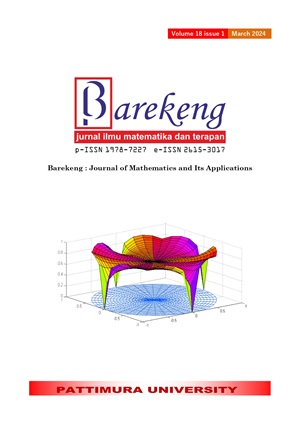SOME CONSTRUCTION OF 8N-DIMENSIONAL PERFECT MAGIC CUBE WITH ARITHMETIC SEQUENCE
Abstract
A magic square whose dimensions are expanded is called a magic cube. A magic cube whose properties are expanded is called a perfect magic cube. The perfect magic cube problem is how to arrange numbers in an cube (matrix) such that the sum of rows, columns, pillars, diagonals (planes and spaces) produces a magic constant of the cube. In this paper, it will be studied how to construct a perfect magic cube of order for whose entries contain an arithmetic sequence with the difference which is set to find specific patterns, and the algorithm for constructing a perfect magic cube is then implemented into programming language to solve large orders.
Downloads
References
P. B. Dhandapani, V. Leiva, and C. Martin-Barreiro, “Construction of a repetitive magic square with Ramanujan’s number as its product,” Heliyon, vol. 9, no. 1, p. e12046, 2023, doi: 10.1016/j.heliyon.2022.e12046.
Z. Duan, J. Liu, J. Li, and C. Tian, “Improved even order magic square construction algorithms and their applications in multi-user shared electronic accounts,” Theor. Comput. Sci., vol. 607, pp. 391–410, 2015, doi: 10.1016/j.tcs.2015.07.053.
O. M. Baksalary, D. Trenkler, and G. Trenkler, “On most perfect magic square of order four,” Linear Multilinear Algebr., pp. 1–13, Jul. 2018.
B. Gupta, “Algorithm for doubly even magic square,” Int. Adv. Res. J. Sci. Eng. Technol., vol. 6, no. 3, pp. 112–117, 2019.
U. A. Mu’min and B. P. Silalahi, “Konstruksi persegi ajaib dengan entri bilangan bulat (magic square construction with integer entry),” J. Mat. dan Pendidik. Mat., vol. 6, no. 2, pp. 166–176, 2021.
S. Duangmoon, P. Kanokladarom, S. Pongprasert, T. Rungratgasame, and N. Srithaisong, “Affine magic cubes of order 4: concepts and applications,” Int. J. Math. Math. Sci., vol. 2022, 2022, doi: 10.1155/2022/2578562.
B. J. Freyberg, “Constructing a tournament with a magic cube,” Am. Math. Mon., vol. 128, no. 8, pp. 719–725, 2021.
C. Ashbacher and L. Widmer, “Magic cube classes,” J. Recreat. Math., pp. 120–121, 2010, doi: 10.5951/mt.43.6.0290.
S. H. Jamel, T. Herawan, and M. M. Deris, “Steps for constructing magic cube using two orthogonal Latin squares and a magic square,” Malaysian Tech. Univ. Conf. Eng. Technol., pp. 1–4, 2009.
L. U. Uko and T. L. Barron, “A generalization of Trenkler’s magic cubes formula,” Recreat. Math. Mag., vol. 4, no. 8, pp. 39–45, 2017, doi: 10.1515/rmm-2017-0019.
F. Liao and H. Xie, “On the construction of pandiagonal magic cubes,” Mathematics, vol. 11, no. 5, pp. 1–23, 2023, doi: 10.3390/math11051185.
O. A. Dawood, A. M. S. Rahma, and A. M. J. Abdul Hossen, “Generalized method for constructing magic cube by folded magic squares,” Int. J. Intell. Syst. Appl., vol. 8, no. 1, pp. 1–8, 2016, doi: 10.5815/ijisa.2016.01.01.
C. Boyer, “Perfect magic cubes,” Multimagie, 2020. http://www.multimagie.com/English/Perfectcubes.htm (accessed Nov. 01, 2022).
G. Guardia and N. B. Do Nascimento, “Arithmetic sequence with multiple reasons,” Am. J. Eng. Res. (AJER, vol. 7, no. 5, pp. 370–376, 2018.
J. F. T. Rabago, “On sequences of numbers in generalized arithmetic and geometric progressions,” Palest. J. Math., vol. 4, no. 1, pp. 170–176, 2015.
J. Arroyo, “A proof of the " Magicness " of the siam construction of a magic square,” Rose-hulman Undergrad. Math. J., vol. 19, no. 1, 2018.
M. C. Tastan and H. Ilhan, “Magic Square Based SM for UAV Communication,” TechRxiv, pp. 1–11, 2023.
B. Alspach and K. Heinrich, “Perfect magic cubes of order 4m,” Fibonacci Q., vol. 19, no. 2, pp. 97–106, 1981.
S. H. Jamel, T. Herawan, and M. M. Deris, “A cryptographic algorithm based in hybrid cubes,” Int. Conf. Comput. Sci. its Appl., pp. 175–187, 2010.
M. Trenkler, “An algorithm for making magic cubes,” Pi ME J., vol. 12, no. 2, pp. 105–106, 2005.
H. . Heinz and J. R. Hendricks, Magic Square Lexicon: Illustrated. HDH, 2000.
E. W. Weisstein, “Perfect Magic Cube,” Wolfram Mathworld, 2003. https://mathworld.wolfram.com/PerfectMagicCube.html (accessed May 01, 2022).
W. S. Andrews, Magic Squares and Cubes. USA: Open Court Publishing, 1917.
M. Trenkler, “Magic cubes,” Math. Gaz., vol. 82, no. 493, pp. 56–61, 1998, doi: 10.5840/monist190616312.
M. Trenkler, “A construction of magic cubes,” Math. Gaz., vol. 84, no. 499, pp. 36–41, 2000, doi: 10.2307/3621472.
Copyright (c) 2024 Ulil Albab Mu'min, Bib Paruhum Silalahi, Sugi Guritman

This work is licensed under a Creative Commons Attribution-ShareAlike 4.0 International License.
Authors who publish with this Journal agree to the following terms:
- Author retain copyright and grant the journal right of first publication with the work simultaneously licensed under a creative commons attribution license that allow others to share the work within an acknowledgement of the work’s authorship and initial publication of this journal.
- Authors are able to enter into separate, additional contractual arrangement for the non-exclusive distribution of the journal’s published version of the work (e.g. acknowledgement of its initial publication in this journal).
- Authors are permitted and encouraged to post their work online (e.g. in institutional repositories or on their websites) prior to and during the submission process, as it can lead to productive exchanges, as well as earlier and greater citation of published works.






1.gif)



